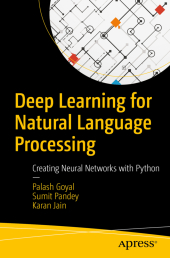 Neuerscheinungen 2018Stand: 2020-02-01 |
Schnellsuche
ISBN/Stichwort/Autor
|
Herderstraße 10
10625 Berlin
Tel.: 030 315 714 16
Fax 030 315 714 14
info@buchspektrum.de |

Palash Goyal, Karan Jain, Sumit Pandey
(Beteiligte)
Deep Learning for Natural Language Processing
Creating Neural Networks with Python
1st ed. 2018. xvii, 277 S. 97 SW-Abb., 2 Farbabb. 235 mm
Verlag/Jahr: SPRINGER, BERLIN; APRESS 2018
ISBN: 1-484-23684-X (148423684X)
Neue ISBN: 978-1-484-23684-0 (9781484236840)
Preis und Lieferzeit: Bitte klicken
Discover the concepts of deep learning used for natural language processing (NLP), with full-fledged examples of neural network models such as recurrent neural networks, long short-term memory networks, and sequence-2-sequence models.
You´ll start by covering the mathematical prerequisites and the fundamentals of deep learning and NLP with practical examples. The first three chapters of the book cover the basics of NLP, starting with word-vector representation before moving onto advanced algorithms. The final chapters focus entirely on implementation, and deal with sophisticated architectures such as RNN, LSTM, and Seq2seq, using Python tools: TensorFlow, and Keras. Deep Learning for Natural Language Processing follows a progressive approach and combines all the knowledge you have gained to build a question-answer chatbot system.
This book is a good starting point for people who want to get started in deep learning for NLP. All the code presented in the book will be available in the form of IPython notebooks and scripts, which allow you to try out the examples and extend them in interesting ways.
What You Will Learn
Gain the fundamentals of deep learning and its mathematical prerequisites
Discover deep learning frameworks in Python
Develop a chatbot
Implement a research paper on sentiment classification
Who This Book Is For
Software developers who are curious to try out deep learning with NLP.
Chapter 1: Introduction to NLP and Deep Learning Chapter Goal: Introduction of Deep Learning and NLP concepts, explanation of the evolution of deep learning and comparison of deep learning with other machine learning techniques in Python No of pages: 50-60 Sub -Topics 1. Deep Learning Framework - An overview 2. Comparison with other machine learning techniques 3. Why Python for Deep Learning 4. Deep Learning Libraries 5. NLP- An overview 6. Introduction to Deep Learning for NLP
Chapter 2: Word Vector representations Chapter Goal: Introduction of basic and advanced word vector representation No of pages: 50-60 Sub - Topics 1. Overview of Simple Word Vector representations: word2vec, Glove 2. Advanced word vector representations: Word Representations via Global Context and Multiple Word Prototypes 3. Evaluation methods for unsupervised word embedding
Chapter 3: Neural Networks and Back Propagation Chapter Goal: Neural Networks for named entity recognition No of pages: 50-60 Sub - Topics: 1. Learning Representations by back propagating the errors 2. Gradient checks, over-fitting, regularization, activation functions
Chapter 4: Recurrent neural networks, GRU, LSTM, CNN Chapter Goal: Deep Learning architectures like RNN, CNN, LSTM, and CNN in great details with proper examples of each No of pages: 70-80 Sub - Topics: 1. Recurrent neural network based language model 2. Introduction of GRU and LSTM 3. Recurrent neural networks for different tasks 4. CNN for object identification
Chapter 5: Developing a Chatbot Chapter Goal: Chatbots are artificial intelligence systems that we interact with via text or voice interface. Our aim is to develop and deploy a Facebook messenger Chatbot. No of pages: 50-60 Sub - Topics: 1. Development of a simple closed context Chatbot 2. Deployment using free server "Heroku" 3. Integrating Seq2seq model with the Chatbot 4. Integrating Image Identification model with the Chatbot Chapter 6: Interaction of Reinforcement Learning and Chatbot Chapter Goal: Detailed explanation of the Reinforcement Learning concept and one of the prevalent case studies/research paper on Reinforcement Learning applications for Chatbot No of pages: 20-30 Sub - Topics: 1. Introduction to Reinforcement Learning 2. Present applications of Reinforcement Learning for Chatbot 3. Detailed explanation of one of the research papers on applications of Reinforcement Learning for Chatbot


